After completing this section, you should be able to:
To find the square root of a number a, think of a number that when multiplied by itself will equal a. In other words, the square root of a is one of two equal factors of a. For example, one square root of 25 is 5 because:
5 · 5 = 52 = 25
Another square root of 25 is –5 because:
(–5) (–5) = (–5)2 = 25
We denote the nonnegative, or principal, square root with the radical sign:
![]()
We denote the negative square root with a negative radical sign:
![]()
An expression containing a radical is called a radical expression. The expression under the radical sign is called a radicand.

Let's summarize these concepts.
Principal and Negative Square Roots
If a is a nonnegative number, then:
We have already seen that to find the square root of a number a, we think of a number that when multiplied by itself will equal a. But how do we find the square root of a variable raised to an exponent? It's easy if we remember that when we multiply, we add exponents. So to find the exponent of the square root, we only have to divide the variable's exponent in half.
Study the examples below (for simplicity, we assume all variables represent positive numbers):
| Remember that x5 · x5 = x10. | |
| Remember that x4 · x4 = x8. | |
| Remember that x11 · x11 = x22. |
Now try some examples yourself to become familiar with these ideas.
| Example 1: | Find the square roots. (Assume all variables represent positive numbers.) |
|
| a. |
Solution | |
| b. |
Solution | |
| c. |
Solution | |
| d. |
Solution | |
| e. |
Solution | |
| f. |
Solution | |
| g. |
Solution | |
| h. |
Solution | |
Numbers such as 1, 4, 9, 16, and 25 are called perfect squares because each is the square of a rational number. Therefore, square roots of perfect squares are equal to rational numbers.
The square root of a number that is not a perfect square, such as ![]() , is not a rational number.
It is an irrational number, and we can find its decimal approximation using a calculator. For example,
, is not a rational number.
It is an irrational number, and we can find its decimal approximation using a calculator. For example, ![]() is approximately equal to 1.732, as written below.
is approximately equal to 1.732, as written below.
![]()
| Example 2: | Use a calculator to approximate
|
| Solution: | Using a calculator,
|
The method we use to find square roots can be extended to find higher-order roots, such as cube roots. The cube root of a number is one of the three equal factors of the number. For example, the cube root of 8 is 2 because:
2 · 2 · 2 = 23 = 8
We indicate the cube root as follows:
![]() = 2
= 2
Remember that when we found the square root of a variable raised to an exponent, we divided the exponent by 2. Now, to find the cube root of a variable raised to an exponent, we divide the exponent by 3. The examples below will help you understand this concept.
| Remember that x1 · x1 · x1 = x3. | |
| Remember that x10 · x10 · x10 = x30. | |
| Remember that 10x4 · 10x4 · 10x4 = 1,000x12. |
Cube Roots
The cube root of a real number a is written ![]() .
.
![]() = b only if b3 = a
= b only if b3 = a
Now practice finding cube roots to ensure you understand this concept.
| Example 3: | Find the cube roots. | |
| a. |
Solution | |
| b. |
Solution | |
| c. |
Solution | |
| d. |
Solution | |
| e. |
Solution | |
We can extend our discussion of square roots and cube roots to include roots other than these two. The nth root of a number a, where n is a natural number greater than 1, is written:
![]()
The number n is called the index, and is usually not shown when we indicate square roots, where n = 2.
We find the nth root of a number or a variable raised to an exponent in the same way we find square and cube roots. To find the nth root of a number, we find a number that when raised to the nth power, gives the original number. In other words, the nth root of a number is one of n equal factors of the number. In the case of a variable raised to an exponent, we divide the exponent by n.
For example (for simplicity, we assume all variables are positive):
| because x5 · x5 · x5 · x5 · x5 = (x5)5 = x25 | |
| because 2 · 2 · 2 · 2 · 2 = (2)5 = 32 | |
| because (–2x2)(–2x2)(–2x2) = (–2x2)3 = –8x6 |
Now try some examples yourself.
| Example 4: | Find the indicated roots. | |
| a. |
Solution | |
| b. |
Solution | |
| c. |
Solution | |
| d. |
Solution | |
We will now look at the cases when the index of the radical is even, and there are variables in the radicand. If we restrict the variables to positive numbers, then the resulting root will be positive.
If the variables are negative numbers, however, we must use absolute-value bars to ensure that the result is a positive number. For example, we write:
![]()
to ensure that the result is positive. The same situation occurs when the index is any even number. Note that when the index is an odd number, absolute-value bars are not necessary. Why?
Try to work out the solutions to the examples below, then look at how we found the answers.
| Example 5: | Find the roots. Variables may represent any real number. |
| a. |
|
| b. |
|
| c. |
|
| d. |
|
| Solution: | a. |
| b. |
|
| c. |
|
| d. (Note that absolute-value bars are not needed in part d because the index is odd.) |
The square-root and cube-root operations can be represented by the functions:
f(x) = ![]() and g(x) =
and g(x) = ![]()
We know that the square root of a negative number is not a real number. Therefore, the domain of the square-root function is the set of all nonnegative real numbers. The domain of the cube-root function, however, is the set of all real numbers because the index is odd.
Now look at the graphs of the two functions ![]() and
and ![]() .
.
| Example 6: | Graph the square root function f(x) = |
||
| Solution: | We know that the domain is the set of all nonnegative real numbers.
Therefore, we evaluate the function for several values of +x, plot the
resulting points, and connect the points with a smooth curve.
Figure 8.1
|
| Example 7: | Graph the function f(x) = |
||
| Solution: | The domain of this function is the set of all real numbers. As before, we will evaluate the function for several values of x, both positive and negative. Then we plot the points and connect them with a smooth curve. Where needed, we will use a calculator to approximate values. Figure 8.2
|
After completing this section, you should be able to:
In this section, we will study expressions that have non-integer exponents, such as 31/2 or x2/3. We will define these expressions so that all the existing rules for exponents will also apply when the exponents are rational numbers.
Let's begin by looking at 51/3. Let:
x = 51/3
Then, by cubing both sides of this equation, we obtain:
x3 = (51/3)3
x3 = 5
From this equation, we can deduce that x is the number whose cube is 5, or:
x = ![]()
This equation leads us to conclude that 51/3 = ![]() .
.
Definition of a1/n
If n is a positive integer greater than 1 and ![]() is a real number, then:
is a real number, then:
a1/n = ![]()
We can use this definition to solve the problems below.
| Example 1: | Use radical notation to write the following. Simplify, if possible. | |||||||||
|
Next, we will expand the discussion of rational exponents to include exponents such as ![]() . As before, we define the meaning of these exponents so that the rules for exponents still hold true.
. As before, we define the meaning of these exponents so that the rules for exponents still hold true.
Now look at the exponential expression 82/3 in two different ways.
Based on the above, we can see that it does not matter whether you:
raise the base to a power first and then take the nth root
or
Definition of am/n
If m and n are positive integers greater than 1 with ![]() in lowest terms, then
in lowest terms, then
![]()
as long as ![]() is a real number.
is a real number.
Now let's apply this definition to the problems below. Try to work out the solutions yourself, then look at our answers.
| Example 2: | Use radical notation to write the following. Simplify, if possible. |
|
|
| Solution: |
Finally, we will discuss the case when the rational exponent is negative.
Definition of a–m/n
If a–m/n is a nonzero real number,
![]()
Study the examples below to see how we use this definition.
| Example 3: | Write each expression with a positive exponent and simplify. |
|
|
| Solution: |

|
The rules for exponents that were developed in module 6 also apply when the exponents are rational numbers. Thus, we can use these rules when simplifying expressions that contain rational exponents. For the remainder of this module, we will assume that variables represent positive real numbers, so that we do not need to use absolute-value bars when simplifying even roots.
For your convenience, we summarize the exponent rules below.
We can apply these rules to examples using rational exponents. Try these examples yourself, and then look at our solutions below. Write the answers with all positive exponents.
| Example 4: |
|
| Solution: | |
Some radical expressions are easier to simplify if we first change them to rational exponents. Then, use the properties of exponents to simplify the exponents, and finally, change the expression back to radical notation.
Let's see how to do this by simplifying ![]() .
.
|
Original expression. |
| (x4)1/8 = x4/8 | Changed to an exponential expression. |
| x1/2 | Simplified the exponent by reducing the fraction. |
| Changed back to radical notation. |
Now try some of these examples yourself before looking at our solutions.
| Example 5: | Use rational exponents to simplify. |
| Solution: |
| Example 6: | Use rational exponents to write as a single radical. |
| Solution: |
After completing this section, you should be able to:
Because radicals can be written as exponential expressions with rational exponents, it follows that the rules for exponents also apply to radicals. In particular, we will look at the product rule and quotient rule.
To verify that the product rule for radicals is valid, study the following:
These two examples show that
![]() , which leads
to the following rule.
, which leads
to the following rule.
Product Rule for Radicals
If ![]() and
and
![]() are real numbers,
then
are real numbers,
then ![]()
Now try to apply this rule.
| Example 1: | Multiply. | ||||
|
|||||
The next example is a little more complicated, so we have worked out the solution for you. |
|||||
| c. |
|||||
We will verify that the quotient rule for radicals is similar to the quotient rule for exponents. Study the two examples below.
These examples show that:
![]()
We can express these findings as the rule below.
Quotient Rule for Radicals
If ![]() and
and ![]() are real numbers, and
are real numbers, and ![]() is not zero, then
is not zero, then
![]()
Now try to apply this rule.
| Example 2: | Use the quotient rule to simplify. | ||||||
|
|||||||
| The next example is a little more complicated, so we will work out the solution for you. | |||||||
c. 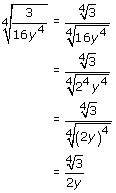 |
|||||||
We can use both the product and quotient rules to simplify a radical.
Study the following examples.
![]()
![]()
Now try some examples yourself.
| Example 3: | Simplify. | ||||
|
Notice that in each case, we simplified the radical so that there are no perfect nth powers in the radicand. For example, if we are simplifying a square root, we make sure that the radicand does not contain any perfect squares. In general, we say that a radicand of the form ![]() is simplified when the radicand a contains no factors that are perfect nth powers (other than 1 or –1).
is simplified when the radicand a contains no factors that are perfect nth powers (other than 1 or –1).
Study the examples below to be sure you understand this process.
| Example 4: | Use the quotient rule to simplify. | ||
|
After completing this section, you should be able to:
Previously, we learned that we can add or subtract like terms by using the distributive property. Similarly, we can use the distributive property to add or subtract like radicals. We begin by defining like radicals as radicals with the same index and the same radicand. Let's look at the following examples to discover the rule for adding and subtracting like radicals.
From these examples, it can be seen that adding or subtracting like radicals is simply a matter of adding or subtracting the coefficients of the like radicals.
Try to do these examples yourself, then look at our solutions.
| Example 1: | Simplify. Assume that variables represent positive real numbers. | ||||||||||||||||
| Solution: |
|
||||||||||||||||
To multiply radical expressions, we can use many of the same properties that were used to multiply polynomial expressions. For example, we can use the distributive property in the problem below.

We can also use the formula for the square of a binomial or the FOIL method to multiply binomials that contain radicals. Study the examples below to be sure you understand this process.
| Example 2: | Multiply.
|
After completing this section, you should be able to:
In this section, we look at division of radical expressions. When we divide radical expressions such as
![]() , we usually want to write the result either without a radical in the denominator or without a radical in the numerator. The process of writing this expression without a radical in the denominator is called
rationalizing the denominator because the denominator in the expression will only contain rational expressions.
, we usually want to write the result either without a radical in the denominator or without a radical in the numerator. The process of writing this expression without a radical in the denominator is called
rationalizing the denominator because the denominator in the expression will only contain rational expressions.
To rationalize the denominator of ![]() , we use the fundamental principle of fractions and multiply both the numerator and the denominator by
, we use the fundamental principle of fractions and multiply both the numerator and the denominator by![]() .
.
![]()
Try the examples below yourself, then look at our solutions.
| Example 1: | Rationalize the denominator of each expression. |
| a. b. c. |
|
| Solution: | a. b. c. |
When the denominator of a radical expression contains two terms, we must use a different method to rationalize the denominator. Recall that if we multiply the sum and difference of two radicals, the result does not contain any radicals.

Note that in this example, there are no radical signs in the answer because the two middle terms added to zero, as they always do when the sum and difference of two identical terms are multiplied. This observation will be useful when rationalizing the denominators of radical expressions.
We call ![]() and
and ![]() conjugates
of each other. The example below shows how we can use conjugates to rationalize the denominator.
conjugates
of each other. The example below shows how we can use conjugates to rationalize the denominator.

Now study the examples below to become familiar with this process.
| Example 2: | Rationalize each denominator. |
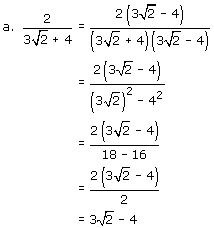 |
|
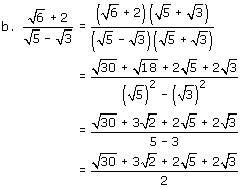 |
|
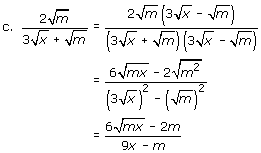 |
We now look at the process of rationalizing the numerator. This process is similar to that of rationalizing the denominator.
| Example 3: | Rationalize the numerator. |
|
After completing this section, you should be able to:
In this section, we look at methods for solving equations containing radical expressions. We will use the power rule to solve these equations.
Power Rule
If both sides of an equation are raised to the same power, all solutions of the original equation are among the solutions of the new equation.
Notice that this property states that the solutions of the new equation may not be solutions of the original equation. Therefore, each solution of the new equation must be checked to make sure it is also a solution of the original equation. If a proposed solution is not a solution of the original equation, it is called an extraneous solution.
Study the example below to see how to solve a radical equation.
| Example 1: | Solve |
| Solution: | Use the power rule to square both sides of the equation.
Check this solution in the original equation.
Therefore, the solution set is {42}. |
We summarize this process below.
Solving a Radical Equation
| Step 1: | Isolate one radical on one side of the equation. |
| Step 2: | Raise each side of the equation to a power equal to the index of the radical and simplify. |
| Step 3: | If the equation still contains a radical term, repeat Steps 1 and 2. If not, solve the equation. |
| Step 4: | Check all proposed solutions in the original equation. |
Now let's apply this process to a more difficult problem.
| Example 2: | Solve |
||||||||||
| Solution: | First, isolate the radical term by subtracting 5 from each side of the equation.
Next, raise both sides to the third power to eliminate the radical.
Now we must check the solution by substituting –9 for x in our original
equation, which was
The solution checks in the original equation, therefore, the solution set is {–9}. |
||||||||||
| Example 3: | Solve |
| Solution: | 
x = or x – 3 = 0 Set each factor equal to 0. There are two solutions to this equation, and we must check both. Check x = 0: Check x = 3: The solution 0 does not check, so 0 is an extraneous solution. |
| Example 4: | Solve |
||||||||||||
| Solution: | First, isolate one radical. It is best to isolate the more complicated one.
Next, square both sides and do the multiplication.
Now, isolate the remaining radical by following the steps above.
The proposed solution checks in the original equation, so the solution set is
|
First, refresh your memory about the Pythagorean theorem.
Pythagorean Theorem
If a and b are the lengths of the legs of a right triangle, and c is the length of the hypotenuse, then a2 + b2 + c2.
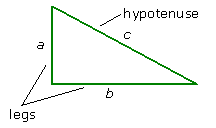
Now let's see how we use this theorem. First, we'll practice just using the theorem, then we'll apply it to a real-world problem.
| Example 5: | Find the length of the unknown leg of the right triangle whose hypotenuse is 10 meters
and one of whose legs is 4 meters.
Figure 8.3
|
| Solution: | We use the Pythagorean theorem, with a = 4, and c = 10.
Because b represents the length of one leg of a right triangle, b cannot be
negative. Why?
Therefore, the unknown leg of the triangle is |
| Example 6: | A 50-foot supporting wire is to be attached to a vertical 75-foot antenna. Because of
surrounding buildings, sidewalks and roadways, the wire must be anchored exactly 20 feet from
the base of the antenna.
Figure 8.4
How high from the base of the antenna is the wire attached? |
| Solution: | From the diagram, we can see that a right triangle is formed with a hypotenuse of 50 feet and
one leg of 20 feet. Let x represent the other leg—the height from the base of the antenna to the
attached wire.
Let a = 20, c = 50, and b = x, the required height.
We will use only the positive value, |
After completing this section, you should be able to:
Earlier in this module, we saw that the square root of a negative number is not a real number.
For example, ![]() is not a real number because no real number exists whose square is –16.
is not a real number because no real number exists whose square is –16.
In this section, we discuss a number system that includes roots of negative numbers. This number system is called the complex number system, and it includes the set of real numbers as a subset. The complex number system allows us to solve equations such as x2 + 1 = 0 that have no real-number solutions. To begin our study of the complex number system, we define the imaginary unit i.
Imaginary Unit
The imaginary unit, written as i, is the number whose square is –1. That is,
![]()
Using this definition, we can write the square root of a negative number in terms of i.
For example, ![]()
Let's practice using the i notation.
| Example 1: | Express in terms of i.
|
Now that we have defined imaginary numbers, we can define complex numbers.
Complex Numbers
A complex number is a number that can be written in the form a + bi, where a and b are real numbers.
Notice that the set of real numbers is a subset of the complex numbers because any real number can be written in the form a + 0i—a complex number.
a + bi is a real number when b = 0. A complex number is called a pure imaginary number if a = 0.
The following diagram shows the relationship between complex numbers and their subsets.
Figure 8.5
Hierarchy of Numbers

Complex numbers can be added or subtracted by adding or subtracting their real parts, and then adding or subtracting their imaginary parts.
Let's look at the rules for these operations.
Sum or Difference of Complex Numbers
If a + bi and c + di are complex numbers, then:
(a + bi) + (c + di) = (a + c) + (b + d)i
(a + bi) – (c + di) = a + bi – c – di = (a – c) + (b – d)i
Now apply these rules to the examples below, then look at our solutions.
| Example 2: | Add or subtract. Write the result in the form a +
bi.
|
| Solution: |
|
We can use the distributive property to multiply complex numbers in the same way we have used it previously. Also, we multiply two complex numbers the same way we multiply two binomials—by using the FOIL method or the rules for special products. Then, we use the relationship i2 = –1 to complete the multiplication process.
Work out the examples below, then look at our solutions.
| Example 3: | Multiply. Write the result in the form a + bi.
|
| Solution: |
|
Notice that in the last example (part d of example 3), the result is a real number. The complex numbers 7 + 3i and 7 – 3i are complex conjugates of one another. When complex conjugates are multiplied, the result is always a real number. A general rule for complex conjugates is given below.
Complex Conjugates
The complex numbers (a + bi) and (a – bi) are called complex conjugates of each other, and:
(a + bi)(a – bi) = a2 + b2
We will use complex conjugates to divide the complex numbers in the examples below. Study these examples to be sure you understand the process.
| Example 4: | Divide. Write the result in the form a + bi. |
a. 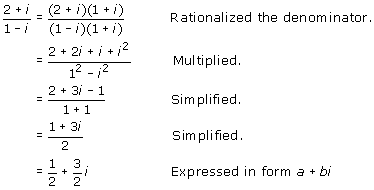
|
|
b. 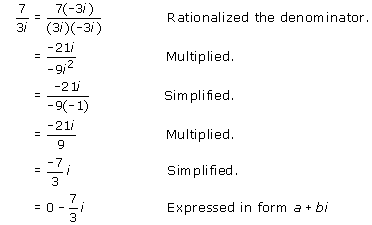
|
Finally, let's examine what happens when we raise the imaginary unit i to an exponent greater than 2. Observe the pattern below.
i2 = –1
i3 = i2 · i = (–1) · i = –i
i4 = i2 · i2 = (–1) · (–1) = 1
i5 = i4 · i = (1) · i = i
i6 = i4 · i2 = (1) · (–1) = –1
i7 = i4 · i3 = (1) · –i = –i
i8 = i4 · i4 = (1) · (1) = 1
i9 = i4 · i4 · i = (1) · (1) · i = i
Notice that this pattern repeats every 4th power. Thus, to find higher powers of i, we use the fact that i4 = 1, and rewrite the power of i in terms of i4.
Study the following example.
i22 = i20 · i2
= i4· i4 · i4 · i4 · i4 ·
i2
= (i4)5 · i2
= (1) · (1) · (1) · (1) · (1) · (–1)
= –1
Now try two examples for yourself. Solving the problems below will help you become familiar with the concept of imaginary numbers.
| Example 5: | Evaluate. | ||||
|